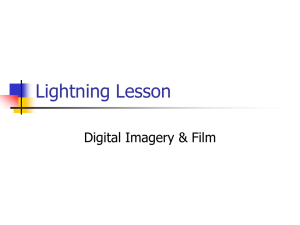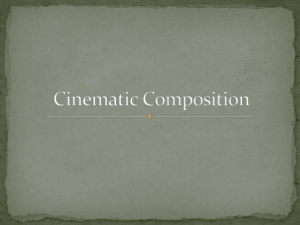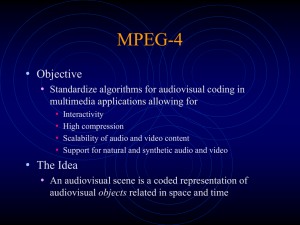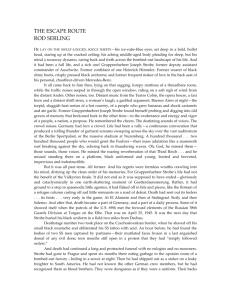Outline Here
advertisement
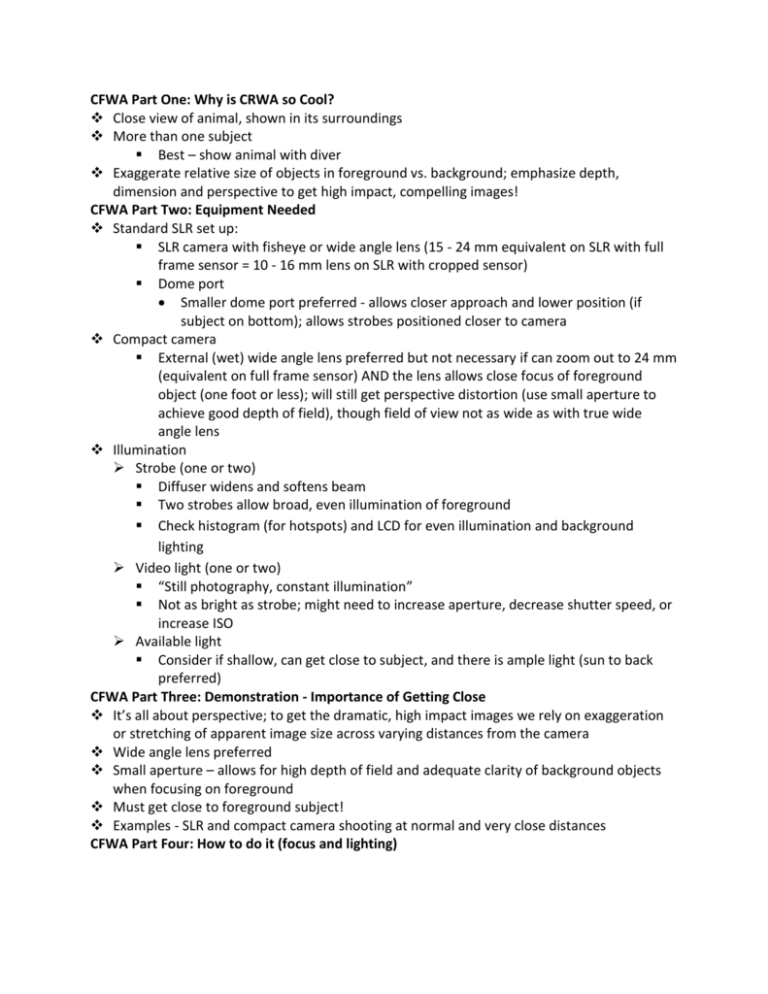
CFWA Part One: Why is CRWA so Cool? Close view of animal, shown in its surroundings More than one subject Best – show animal with diver Exaggerate relative size of objects in foreground vs. background; emphasize depth, dimension and perspective to get high impact, compelling images! CFWA Part Two: Equipment Needed Standard SLR set up: SLR camera with fisheye or wide angle lens (15 - 24 mm equivalent on SLR with full frame sensor = 10 - 16 mm lens on SLR with cropped sensor) Dome port Smaller dome port preferred - allows closer approach and lower position (if subject on bottom); allows strobes positioned closer to camera Compact camera External (wet) wide angle lens preferred but not necessary if can zoom out to 24 mm (equivalent on full frame sensor) AND the lens allows close focus of foreground object (one foot or less); will still get perspective distortion (use small aperture to achieve good depth of field), though field of view not as wide as with true wide angle lens Illumination Strobe (one or two) Diffuser widens and softens beam Two strobes allow broad, even illumination of foreground Check histogram (for hotspots) and LCD for even illumination and background lighting Video light (one or two) “Still photography, constant illumination” Not as bright as strobe; might need to increase aperture, decrease shutter speed, or increase ISO Available light Consider if shallow, can get close to subject, and there is ample light (sun to back preferred) CFWA Part Three: Demonstration - Importance of Getting Close It’s all about perspective; to get the dramatic, high impact images we rely on exaggeration or stretching of apparent image size across varying distances from the camera Wide angle lens preferred Small aperture – allows for high depth of field and adequate clarity of background objects when focusing on foreground Must get close to foreground subject! Examples - SLR and compact camera shooting at normal and very close distances CFWA Part Four: How to do it (focus and lighting) Aperture – keep small to maintain high depth of field; unfortunately, this reduces light allowed to the camera sensor; can use strobe for foreground exposure but for adequate exposure of background, might need to use lower shutter speed, or increase ISO Shutter speed - flash stops action and allows lighting for foreground but might need lower shutter speed (maybe as low as 1/25th second) to allow for adequate exposure of background; however, low shutter speed could result in blurred image from object or camera motion ISO – generally prefer lowest ISO possible to minimize noise; however, to prevent shutter speed from being too low (such that blurred image from motion blur would result), might need to increase ISO Focus Focus on near object; lock focus, then recompose and depress shutter; keep smaller aperture for good depth of field Lighting Shutter speed and ISO for background exposure Strobe or video light for foreground exposure Strobes Control foreground exposure by adjusting strobe power, strobe to subject distance, strobe position, and strobe direction Even low power restores color and clarity of foreground object Use diffusers to broaden and soften cone of light Two strobes allow more even lighting of foreground, eliminate harsh shadows Check histogram for over-exposure and LCD for even illumination of foreground If one strobe, might position foreground subject to the side that strobe is on Video light – constant illumination for still photography Advantages Even some lighting will some color, contrast, and clarity of foreground object Can see area of coverage, shadows, and hot spots prior to depressing shutter Do not have to worry about strobe not discharging Smaller, lighter Aid in focusing Disadvantages Even highest power video lights not as powerful as strobe Might need to decrease shutter speed or increase ISO Probably won’t get images as sharp or brilliant as with strobe Limited battery time if constant illumination Available light Adequate if in shallow water, good lighting (sun to back), AND get close to foreground subject CFWA Part five: Composition Show animal in context of environment Multiple subjects; show animal on reef, with other animals, and (best) with diver Emphasize perspective for depth and impact Exaggerate size of object in foreground relative to background Show layers of depth (under surface, leading lines) Balance and dynamics – placement and orientation of subjects in image Pleasing background, rule of thirds, balance, diagonals, symmetry Distractions Not close enough Horizon not level Too many subjects – keep it simple! If a subject doesn’t add to the image, try to leave it out Poor placement or orientation of subject in frame (no swimming or breathing room) Poor profile or appearance of subject (poor diver profile; dangling equipment, bubbles, poor gaze) Merger of subject with other subjects, background Amputation of parts of subject CFWA Part Six: Examples and Critiques CFWA Part Seven: Examples and Critiques

